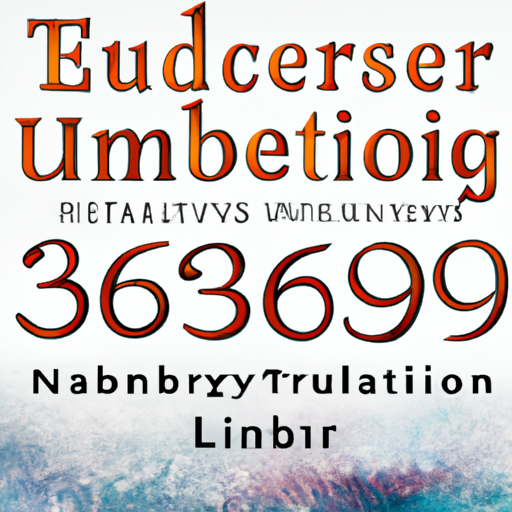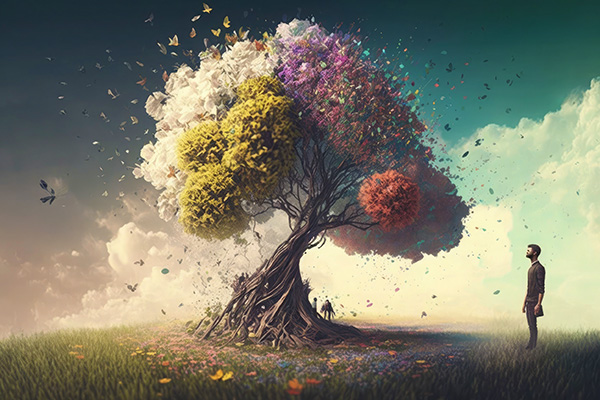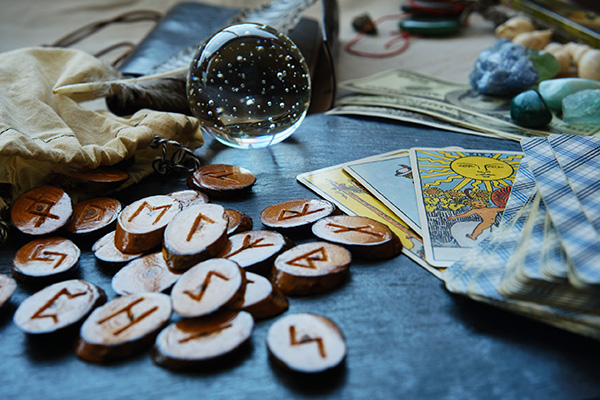Get Ready for an Invigorating Spring Spiritual Revival
 Today is the Spring Equinox, signaling the first day of spring in the Northern Hemisphere. Also referred to as the Vernal Equinox, this astronomical phenomenon signifies one of the two moments of the year when day and night are almost equal in duration. It generally takes place around March 20th or 21st in the Northern Hemisphere.
Today is the Spring Equinox, signaling the first day of spring in the Northern Hemisphere. Also referred to as the Vernal Equinox, this astronomical phenomenon signifies one of the two moments of the year when day and night are almost equal in duration. It generally takes place around March 20th or 21st in the Northern Hemisphere.
During the equinox, the sun crosses the celestial equator and begins its journey northward. Numerous cultures and traditions commemorate this time as a moment of equilibrium, rejuvenation, and development. As nature achieves balance, we too are encouraged to follow suit — to eliminate what no longer benefits us and transition into a period of brightness, activity, and fresh starts.
Spring symbolizes a fresh start. A new sun ascends. The dawn in the calendar year. At this season, our thoughts are vibrant and filled with innovative ideas. Many of us feel motivated and eager to explore new ventures. Life emerges in the gentle warmth of sunlight, and our spirits appear ready for a fresh chapter.
One enduring practice linked to this season is the custom of “spring cleaning.” Throughout history and various cultures, individuals have utilized this time to revitalize their homes, remove accumulated clutter, and welcome new energy into their lives.
However, spring cleaning extends beyond merely tidying up our physical surroundings — it represents a sacred ceremony of rejuvenation, release, and transformation. As the earth stirs from its slumber, we too are beckoned to discard the old and create space for new vitality. From a spiritual perspective, this process offers a chance to realign ourselves with elevated frequencies, eliminate stagnant energy, and invite clarity into our existence.
The beautiful spring arrived, and as nature regains her charm, the human spirit tends to revive as well ~ Harriet Ann Jacobs
Clutter, whether physical or energetic, carries the burdens of the past. Old items, especially those associated with emotional experiences, can ensnare memories and vibrations that no longer aid us. By deliberately clearing them away, we indicate to the universe that we are poised to move ahead. This notion applies to relationships, cognitive patterns, and even beliefs that we have outgrown.
The Spiritual Traditions Of Spring
Spring and the Vernal Equinox are rich in traditions, beliefs, and mystical practices worldwide. It traditionally represents a period closely linked to renewal, fertility, and growth, rendering it a powerful symbol in various religious and esoteric practices. It embodies a time of rejuvenation, reawakening, rebirth, hope, and the victory of light over darkness as nature awakens after the stillness of winter.
Ancient pagan societies honored Ostara, a festival dedicated to Ostara, also known as Ēostre, the goddess of spring, dawn, and fertility. Her name connects to the Old English term for the month of April, Ēosturmōnaþ, as noted by the 8th-century monk Bede.
Eggs and hares, now recognized as symbols of Easter, were sacred to Ostara, representing fertility and the life cycle. Although historical references to Ostara are sparse, she is celebrated in contemporary pagan and Wiccan traditions during the Spring Equinox, recognizing her role as a bringer of illumination and life. Her narrative and imagery continue to inspire those seeking to connect with nature’s cycles and the themes of rebirth and balance.
In Christianity, spring corresponds with Easter, which commemorates the resurrection of Jesus Christ. This celebration of triumph over death mirrors the natural cycles of renewal that spring brings. The inclusion of eggs and flowers in Easter traditions reflects earlier pagan symbols of vitality and resurrection.
The Hindu festival of Holi, recently celebrated over March 13th and 14th, marks the arrival of spring and emphasizes themes of love, joy, and the victory of good over evil. Participants throw colored powders to symbolize the flourishing of life, unity, and forgiveness.
Purim, recently observed on March 14th, is a joyous Jewish holiday that commemorates the biblical tale of Queen Esther, who rescued the Jewish populace from peril in ancient Persia. Celebrated with feasts, costumes, and the reading of the Megillah (Book of Esther), Purim signifies triumph over challenges and the renewal of hope. Its timing in early spring resonates with themes of rebirth and metamorphosis, much like nature’s revival following winter’s chill. Just as the earth begins to bloom again, Purim represents the emergence of joy, resilience, and divine oversight, reminding us that renewal is achievable even during the toughest times.
In the Japanese Shinto tradition, the equinoxes are celebrated as Higan, a moment to pay respects to ancestors and contemplate life’s balance. Families visit graves, perform rituals, and enjoy nature in harmony with the season’s spirit of renewal. In Japanese culture, the blooming of cherry blossoms (sakura) symbolizes life’s transient beauty and the refreshing of the spirit. The hanami (flower viewing) tradition invites contemplation and appreciation for life’s brief yet beautiful moments.
In esoteric beliefs, spring is perceived as a time for purification. Practices such as herbal smudging, spring cleaning, or fasting are employed to cleanse the body, mind, and spirit. The equinox’s balance is believed to provide an energetic opportunity, making it a potent time for rituals focused on harmony, rejuvenation, and connection with nature.
Contemporary mystical spring practices involve “planting intentions,” both in a metaphorical and literal sense. Just as seeds are sown in the earth, individuals set new goals and aspirations for growth. Rituals such as crafting altars adorned with flowers, greenery, and seasonal symbols are commonplace. Meditation and visualization methods are used to harmonize with the rejuvenating energy of spring.
Throughout cultures, spring resonates as a period of hope, renewal, and a profound connection between humanity and nature. It is a moment to align with the energies of transformation and personal growth. The burgeoning life in nature serves as a metaphor for shedding outdated patterns and welcoming new opportunities.
If you’ve never been thrilled to the very edges of your soul by a flower in spring bloom, maybe your soul has never been in bloom ~ Audra Foveo
Spiritual Spring Cleaning
A potent method to weave spiritual intention into your annual spring cleaning is through a cleansing ritual or ceremony.
Our homes act as extensions of our energy fields. When our surroundings are cluttered with dust, broken objects, or items we no longer cherish, it can reflect and reinforce internal blockages. Spring cleaning is an act of self-care that assists us in realigning with our fullest potential.
Smudging with sage or palo santo, utilizing sound healing with bells or chimes, or even setting intentions as you declutter can amplify the effects. We can affirm each time we release:
I am letting go of what no longer benefits me and creating space for new blessings to enter.
Consider the impact of rearranging furniture or introducing fresh flowers to attract new energy. Even opening windows to welcome fresh air can alter the vibration of a room. These small yet intentional actions elevate the frequency of our environment, fostering harmony and flow.
I will always plant a large garden in the spring. Who can resist the feelings of hope and joy that one gets from participating in nature’s rebirth? ~ Edward Giobbi
Creating Space For New Possibilities
I recall working with a client last year who felt trapped for months — grappling with low energy, recurring relationship issues, and an inexplicable sense of heaviness. She sought guidance, and during our session, I sensed that her home was retaining dense energy from past experiences.
I encouraged her to conduct a thorough spring cleaning, both physically and spiritually. Together, we pinpointed critical areas in her home needing attention, especially her bedroom, which still bore the emotional residue of a past relationship. I guided her through a ritual using salt, candles, and visualization to sever energetic ties and welcome renewal.
A week later, she reached out to me with enthusiasm — she felt lighter, her sleep had improved, and unexpectedly, a new career opportunity had surfaced. By clearing the stagnation from her home, she had made way for new possibilities to emerge in her life.
Spring cleaning invites us to release, realign, and renew — both externally and internally. When approached with mindfulness, it transforms into a sacred practice that bolsters our spiritual development. As we discard the old, we create space for the universe to fill our lives with fresh energy, love, and prospects. Now is the moment to establish new aspirations and sow the seeds of transformation.
This year, the Spring Equinox aligns with Mercury retrograde, presenting a unique chance for introspection and course correction. Instead of perceiving retrograde energy as an obstacle, we can view it as an opportunity to rebalance our lives and implement meaningful changes. Spring carries the promise of fresh starts, and with conscious action, we can attune ourselves to its abundant, revitalizing energy.
Embrace this season fully, understanding that by letting go of what no longer aids you, you are stepping into a time of growth, revival, and boundless possibilities.
|
Mystic Shelley is a five-star psychic, Reiki healer, clairvoyant, and empathic reader. She provides her clients with honest insights regarding past, present, and future events with the help of her trusted guides. She specializes in love, relationships, careers, finances, and life’s various aspects. Mystic Shelley was born with abilities that would later identify her as a gifted psychic, but she initially chose not to embrace them. During her 30s, a fortuitous meeting with a renowned psychic set her on a path that awakened her talents. Being born with clairvoyance and empathy, her psychic mentor helped her hone those skills, enhancing her abilities. With time came expertise, and now she has an expanding list of loyal clients who highly commend her work. Moreover, she actively assists other psychics in discovering their abilities. If you seek straightforward and sincere answers, schedule a reading with Mystic Shelley now at PsychicAccess.com |
Get Ready for a Revitalizing Spring Spiritual Renewal
As winter gradually departs, clearing the way for spring’s arrival, it’s an ideal time to embark on a journey of spiritual rejuvenation. Just as nature awakens and blooms, our spirits too can be revitalized and refreshed during this season. Here are some key steps to help you prepare for a genuinely transformative spiritual renewal this spring.
1. Reflect on the Past Season:
Before initiating a new spiritual journey, pause to reflect on the previous season. Contemplate the challenges faced, lessons learned, and personal growth achieved. Reflecting on the past allows you to gain clarity on areas where your spiritual renewal efforts may be needed.
2. Set Intentions:
Setting intentions is a powerful way to synchronize your mind, body, and spirit. Take time to ponder what you wish to attain during this spring spiritual renewal. Whether it involves cultivating inner peace, deepening your connection to nature, or practicing self-compassion, having clear intentions will direct your actions and help maintain focus.
3. Create a Sacred Space:
Establishing a designated area for your spiritual practices can significantly enhance your renewal experience. Choose a corner of your home or garden as a sacred space for meditating, praying, or simply being present with your thoughts. Adorn this space with items that inspire and uplift you, such as candles, crystals, or meaningful artifacts.
4. Engage in Mindful Practices:
Spring is a season of awakening, and practicing mindfulness can help you fully embrace this period of renewal. Engage in activities such as meditation, yoga, or breathwork to foster awareness and presence. These practices can assist you in letting go of the past, releasing negative energy, and opening yourself to new opportunities.
5. Connect with Nature:
Spring beautifully invites you to reconnect with the natural world. Spend time outdoors, whether walking in the park, nurturing a garden, or simply sitting beneath a tree. Absorb the beauty of nature, listen to the birds sing, and feel the earth beneath your feet. Connecting with nature can ground you and bring harmony to your spiritual renewal journey.
6. Seek Community and Support:
Embarking on a spiritual renewal journey does not necessitate solitude. Look for like-minded individuals who share your spiritual interests. Join a local meditation group, attend workshops or retreats, or take part in online communities. Surrounding yourself with supportive people can provide encouragement, direction, and a sense of belonging.
7. Practice Gratitude:
Gratitude serves as a potent tool for spiritual renewal. Dedicate time each day to express gratitude for the blessings in your life, regardless of their size. Cultivating a grateful mindset can shift your attention from what’s lacking to what’s abundant, fostering feelings of contentment and joy.
8. Embrace Self-Care:
Caring for your physical, emotional, and mental well-being is essential for a successful spiritual renewal. Prioritize self-care activities that replenish your energy and promote inner balance. This might include ensuring adequate sleep, eating nourishing foods, participating in enjoyable hobbies, or seeking professional support when necessary.
9. Embrace Change:
Spring embodies change and growth. Welcome this natural cycle by staying open to shifts in your life. Release outdated habits, beliefs, or relationships that no longer serve a purpose. Welcome new opportunities, explore various spiritual practices, and be willing to step outside your comfort zone. Embracing change can facilitate profound spiritual growth and transformation.
10. Practice Compassion:
Finally, as you step into your spring spiritual renewal, remember to extend compassion, both to yourself and others. Be patient with yourself as you navigate this journey, and show kindness and understanding to those around you. Compassion serves as a powerful force that fosters deep connections and cultivates a more harmonious world.
Spring is a season of renewal and growth, both in the natural world and within ourselves. By following these steps and aligning yourself with the energy of the season, you can undertake a transformative spiritual journey. Get ready to awaken your spirit, nurture inner peace, and experience a refreshing spring spiritual renewal. Continue reading














